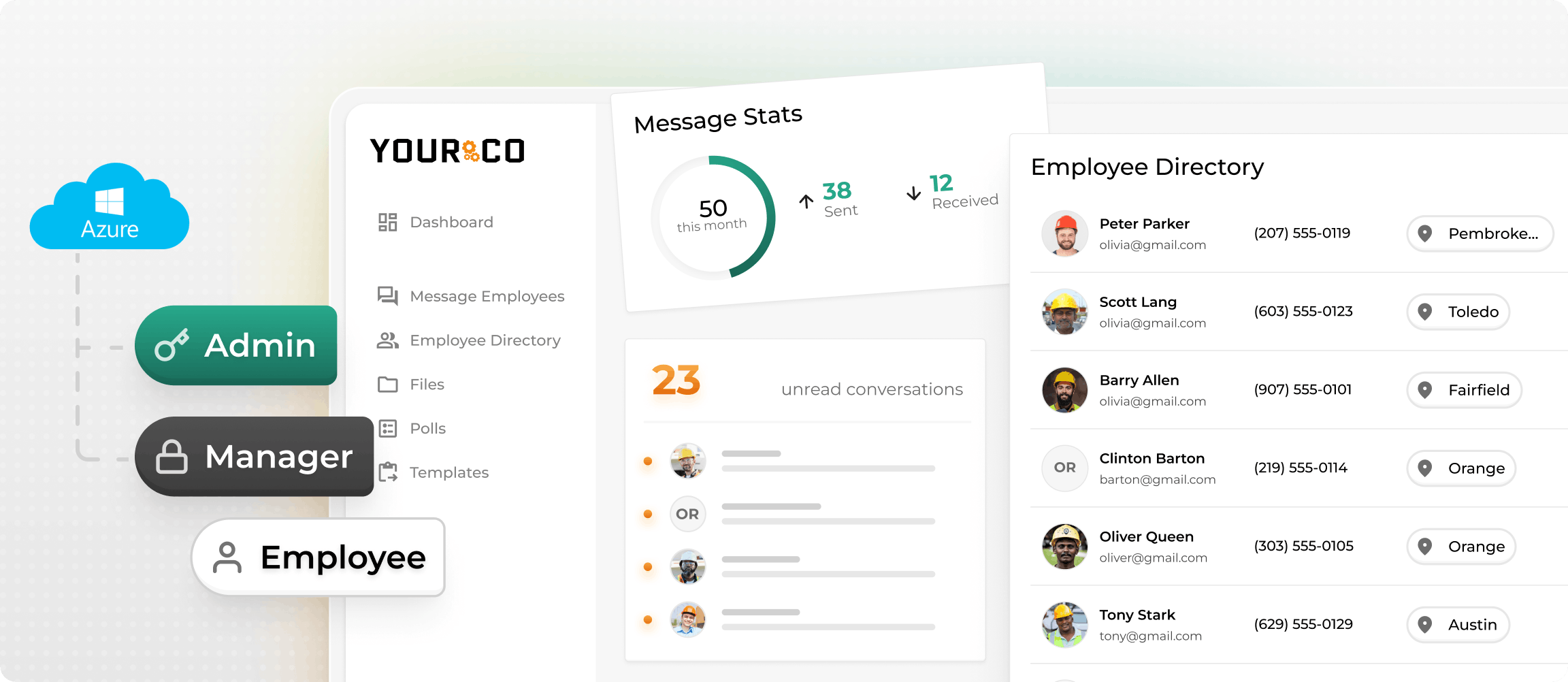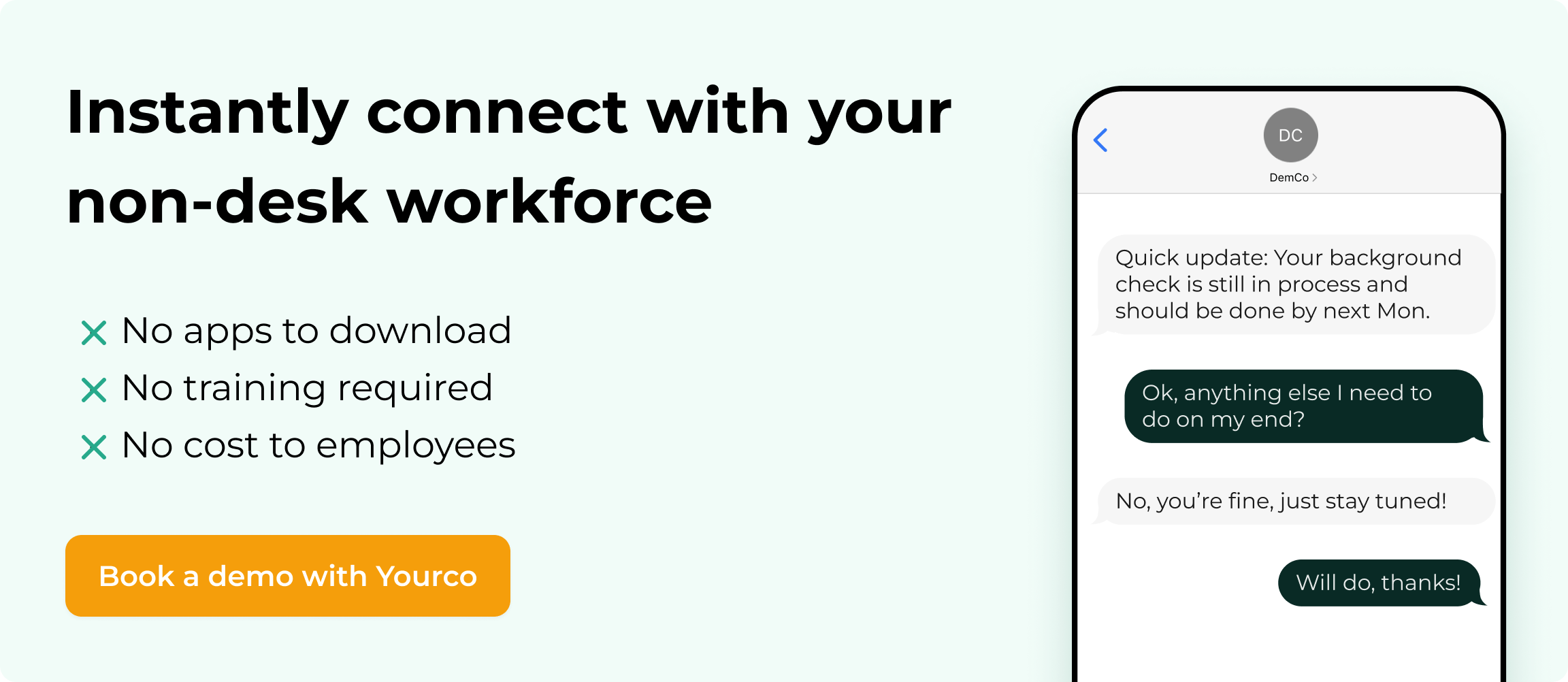The Power of SMS in Your Pre-Onboarding Process


Pre-onboarding can be hectic. You send contracts, chase signatures, juggle background checks, and still wonder if the new hire will show up. Paperwork stalls, emails get buried, and last-minute ghosting leaves shifts uncovered and budgets in limbo.
The chaos is worse for non-desk teams. Most frontline employees work on shop floors, hospital wings, or job sites, not behind laptops. The vast majority of the global workforce is deskless, yet they receive minimal workplace technology investment, leaving big communication gaps for HR and ops managers who rely on email or portals that these workers rarely check.
SMS cuts through that noise by reaching any phone — flip, smart, online, or offline — with near-certain visibility and 98% open rates. This high engagement keeps paperwork moving, questions answered, and enthusiasm high before day one.
The following guide reveals practical steps to swap scattered emails and missed calls for instant, reliable touchpoints. The goal is to turn pre-onboarding chaos into a smooth launch that builds trust, slashes no-shows, and gets every new hire ready to contribute from their first shift.
What Makes Pre-Onboarding So Important?
Pre-onboarding covers those crucial days or weeks between "You're hired" and when a new teammate shows up for their first shift. During this window, you either keep new hires excited about starting or watch their enthusiasm disappear. When paperwork gets delayed, questions go unanswered, and instructions sit buried in crowded inboxes, new hires start having second thoughts, and some never show up at all.
Early turnover is costly, yet companies that deliver a structured early experience see significant retention improvements. The stakes are even higher for non-desk workers, who make up the vast majority of the workforce but face unique communication challenges. Many rely on personal phones, and a significant portion rarely check email during a shift, so important updates often never reach them.
Getting pre-onboarding right stops ghosting, protects retention budgets, and helps people reach productivity targets faster. The goal is to reach every new hire quickly, answer questions before they grow into problems, and prove through clear, timely guidance that they made the right choice joining your team.
Why SMS Beats Email and Apps for Pre-Onboarding
You need a channel that reaches every new hire the first time. SMS does that; email and mobile apps do not.
Apps sound modern, but they create unnecessary barriers. New hires have to find the app, download it, create a password, and keep data turned on. Even when companies push hard, many employees don't end up using them. For frontline workers, those extra steps feel like a hassle, especially if they don’t use modern devices, pay for their own data, or forget login details.
Email works better than apps, but still falls short in the field. Onboarding messages get buried in busy inboxes, filtered as spam, or ignored until the next break. Messages can take days to be seen, leading to missed paperwork, unanswered questions, and last-minute no-shows.
Texting cuts through all that friction since any basic phone works — no internet, downloads, or passwords required. SMS enjoys consistently high open rates, and most texts get read within minutes. Messages pop up on the lock screen, so new hires see start-time reminders, parking maps, or document requests right away.
SMS also works well for multilingual teams. Short, plain text translates easily, and most phone keyboards already support multiple languages. A Spanish-speaking line cook and an English-speaking supervisor both get the same timely update in their preferred language without complicated settings needed.
Texts also feel personal. A quick "Welcome aboard, Maria! Your first shift starts at 7 a.m. Monday" makes a stronger impression than a generic email blast. When new hires feel seen and informed, they're far less likely to ghost you before day one.
SMS meets people where they are: on their phones, in the flow of their day, without extra steps. Your pre-onboarding messages land faster, clearer, and with much less follow-up.
What You Can Do With SMS Before Day One
A few simple texts can cut through the paperwork chaos and transform those critical days between offer acceptance and first shift. Before your new hire clocks in, you can welcome them, handle documents, share directions, and answer questions — all through their phone. Here's how to turn that quiet period into smooth preparation.
Get Consent Before You Start Texting
While we’re not legal professionals, the guideline is simple: let employees know that SMS will be used for important, work-related communication. For internal updates like schedules, safety alerts, and company news, you don’t need a complex consent process, a clear communication and an opt-out option.
The easiest approach is to include this in your existing onboarding process such as your employee handbook, offer letter, or digital onboarding portal:
"We use text messaging to share important work-related updates. You’ll be automatically enrolled using the phone number provided and can opt out at any time by replying STOP."
You can also mention it during your welcome conversation with new hires so they know what to expect. As long as employees are notified upfront and have an easy way to opt out, you can keep everyone informed without adding extra administrative steps.
Send Welcome Messages That Actually Get Read
First impressions matter, especially when new hires feel nervous about starting. A friendly text shows you're organized and genuinely excited to have them join your team. Make it personal by pulling their name, role, and start date directly from your system through automated fields:
"Hi [Name], welcome to [Company]! We're excited you'll start as [Role] on [Start Date]. Here's what your first morning looks like: [link]. Can't wait to see you!"
When your workforce speaks different languages, translation tools can convert that same message into many languages instantly. Everyone gets included without you rewriting anything.
Share First-Day Logistics and Arrival Info
New hires stress about the basics: where to park, what to wear, who to call. Send clear logistics three to five days before they start, then set an automatic reminder the night before. Since SMS stays right on their phone with their maps and ride apps, they can check it in the parking lot instead of hunting through emails. Schedule these messages ahead of time and confirm they were delivered.
Example: "Reminder: Your first shift starts 7 am Monday at 2100 West Elm, Door C. Free lot parking, steel-toe boots required, bring photo ID and banking info for paperwork. Questions? Reply here—HR is ready to help."
Collect Documents and ID via SMS
Paperwork usually creates delays. With SMS, new hires snap a photo of their I-9 or direct-deposit form and text it back. Secure systems protect each file with unique PINs and track every transfer for compliance, cutting the back-and-forth that slows down day one.
Deliver Training Materials in Small Pieces
Long manuals overwhelm new hires. Break important content into digestible chunks:
- A short safety video
- A quick guide to company values
- A checklist for first-shift procedures
Send one piece per day so they can learn without feeling rushed. When onboarding is broken into manageable steps, more employees hit their first performance goals. Secure links keep materials protected, and you control when each piece expires.
Answer Questions in Real Time
When new hires have questions and hear nothing back, they get anxious, sometimes anxious enough to not show up. Two-way texting lets them ask "Where do I park?" or "Do I need lunch?" and get answers fast. Immediate alerts notify HR when messages come in, so nothing gets missed. Quick responses ease worry and support the retention boost that comes with solid onboarding preparation.
Schedule Automated Check-Ins
Schedule regular touchpoints: right after the offer, one week out, day before, and morning of their start. Use scheduled messages for consistent timing, but stay ready for personal follow-ups when someone raises a concern. A simple "Ready for tomorrow?" text the night before catches last-minute issues you can fix before they become problems. Regular contact keeps momentum going and makes no-shows much less likely.
Benefits of SMS-Based Pre-Onboarding for HR and Ops Teams
Switching your pre-onboarding tasks to SMS creates immediate improvements across your team. Since replies come back fast with SMS, those I-9 forms, direct-deposit paperwork, and emergency contacts arrive on your desk days sooner. This shrinks your paperwork window and cuts down on follow-up calls.
Faster preparation directly impacts your bottom line. Companies that create a strong start for employees see higher retention rates and improved productivity. When fewer people leave early, you also protect your budget, as replacing a lost hire is expensive, not counting the overtime your team pays to cover the gap.
Your record-keeping gets cleaner as well. Every text comes with a time stamp, stays searchable, and lives in one organized place. If auditors ask questions, you can show exactly what was sent and when. These logs also help managers spot where new hires get stuck, making it easier to smooth out the pre-onboarding process.
Automation delivers the final advantage. Scheduled texts and templates handle reminders, check-ins, and surveys while your team tackles higher-value work. HR managers spend less time chasing down signatures, talent acquisition leaders see fewer no-shows, and operations teams welcome new workers who already know where to go and what to bring.
Tips to Get Started With SMS-Based Pre-Onboarding
You don't need a giant tech project to begin; a clear plan and the phone numbers you already hold are enough. Because many frontline employees rely on their own phones for HR tasks, closing communication gaps with text messages delivers quick wins that email or portals can't touch.
- Notify first: Before implementing SMS pre-onboarding, update your offer process or onboarding materials to let new hires know you’ll be using text messages for work-related communication. Include a simple opt-out option so they can choose their preferred communication method. This keeps employees informed and ensures transparency from day one.
- Map your current gaps: Start by auditing your entire flow from offer letter to first shift, noting delays, duplicate work, and anything still handled on paper. This foundation helps you identify exactly where SMS can make the biggest impact.
- Design a simple workflow: Use a whiteboard or lightweight workflow builder to pair each task with a triggered text. Keep it straightforward — complex workflows often fail because they're too hard to maintain.
- Schedule regular touchpoints: right after the offer, one week out, day before, and morning of their start. Use scheduled messages for consistent timing, but stay ready for personal follow-ups when someone raises a concern.
- Build a template library: Create short, reusable messages for welcomes, logistics, document requests, and check-ins. A template bank speeds rollout and ensures consistency across all new hires.
- Segment by role and location: A warehouse associate doesn't need the same arrival instructions as a clinic nurse. Tag phone numbers so messages stay targeted and concise, reducing confusion and improving engagement.
- Perfect your timing: Send the first welcome within 24 hours of offer acceptance, logistics three days before start, and a reminder the evening prior. You'll know those notes land when they need to.
- Stay compliant throughout: Since you've collected written opt-in during the offer process, focus on protecting sensitive data and storing replies securely. Always honor opt-out requests and maintain consent records for your files.
Yourco trims even more effort by bundling pre-built templates, opt-in capture, AI translations, and scheduled sends in one dashboard — so you spend minutes setting up, not weeks coding workflows.
Start Pre-Onboarding Efficiently With Yourco

Getting pre-onboarding right shouldn't feel like a juggling act. With Yourco, you reach every new hire instantly, collect paperwork sooner, and cut the back-and-forth that drags the process out. That immediacy keeps enthusiasm high and lets you solve problems before day one.
Yourco is built for crews who spend shifts on shop floors, loading docks, or patient floors — not behind desks. Because everything happens over SMS, new hires don't need an app, data plan, or company login. They simply reply to your texts.
When you're dealing with multilingual teams, Yourco's AI-powered translations cover 135+ languages and dialects, so no one feels left out. Secure document requests let hires snap a photo of IDs or tax forms and send them back through an encrypted link — no printing, no email chains. Two-way messaging keeps questions and answers in one place, while automatic logs give you a clear audit trail. Seamless HRIS integrations push start dates, roles, and other details straight into your text templates, saving time on data entry.
Teams that pair structured preparation with quick, clear communication often see significant improvements in retention and engagement. Ready to give your new hires that kind of start? Try Yourco free today or book a demo to see paperwork wrap up and excitement build before the first shift even begins.
Frequently Asked Questions
Is it legal to text new hires before they officially start working?
It’s fine to text new hires before their official start date, as long as you’ve informed them that SMS will be used for work-related communication and provide a clear way to opt out. Yourco is an SMS-based employee platform built for internal employee communication, making it easy to send welcome messages, training reminders, and important updates before day one.
When should I get consent to text new hires?
Most companies collect this during the application or offer acceptance process. You can simply include a consent checkbox, but it’s a good idea to clearly state what types of messages they'll receive and always provide an easy opt-out option. You could collect consent on the first day, but getting it earlier lets you use SMS for pre-onboarding communication like welcome messages and first-day logistics. You can also include it as part of the employee handbook so expectations are clear from the start.
What if new hires don't respond to texts or don't have smartphones?
SMS works on any phone that can receive text messages, including basic flip phones. If someone doesn't respond, you can follow up with a quick call to ensure they received the information. Most people are comfortable with texting, but having backup communication methods is always smart.
Can SMS pre-onboarding integrate with our existing HRIS system?
Yoruco is an SMS platform that offers integrations with 240+ HRIS and payroll systems. This allows you to automatically pull new hire information like names, start dates, and roles directly into your text templates, reducing manual data entry and errors.
What happens if someone opts out of SMS during pre-onboarding?
You should have backup communication methods ready, typically phone calls. However, make sure to explain what they'll miss by opting out, like time-sensitive reminders about required documents, first-day logistics, open enrollment reminders, benefit package information, and other important updates, so that they can make an informed decision.




